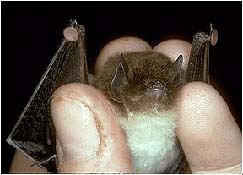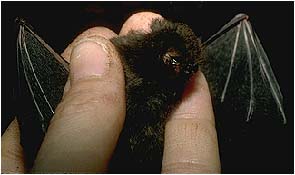Nataloidea
Nancy B. Simmons and Tenley Conway


This tree diagram shows the relationships between several groups of organisms.
The root of the current tree connects the organisms featured in this tree to their containing group and the rest of the Tree of Life. The basal branching point in the tree represents the ancestor of the other groups in the tree. This ancestor diversified over time into several descendent subgroups, which are represented as internal nodes and terminal taxa to the right.

You can click on the root to travel down the Tree of Life all the way to the root of all Life, and you can click on the names of descendent subgroups to travel up the Tree of Life all the way to individual species.
For more information on ToL tree formatting, please see Interpreting the Tree or Classification. To learn more about phylogenetic trees, please visit our Phylogenetic Biology pages.
close boxIntroduction
Nataloidea comprises four small families: Myzopodidae (which is monotypic), Thyropteridae (1 genus and 3 species), Furipteridae (2 genera and 2 species), and Natalidae (1 genus and 6 species; Koopman, 1993; Pine, 1993; Simmons, 1998; Simmons and Geisler, 1998). Thyropteridae, Furipteridae, and Natalidae are all Neotropical in distribution, but Myzopodidae is found only in Madagascar. Nataloids live only in tropical areas, and most species are found in rainforest habitats. All nataloids are insectivores that catch their prey on the wing.
Characteristics
All Nataloidea share the following features:
- ear pinnae more or less funnel-shaped.
- three lower premolars in each side of jaw.
- modifications of the hyoid apparatus including m. geniohyoid originating from pronglike process that extends posteroventrally from symphysis region, m. geniohyoideus origin extended laterally onto medial surface of mandible, occupying anterior one-forth to one-third of medial mandibular surface, ventralmost fibers of m. genioglossus fused to fibers from caudal portion of m. geniohyoideus, and ventralmost fibers of m. genioglossus inserts onto basihyal.
- wing digit II with ossified first phalanx unossified or absent.
Discussion of Phylogenetic Relationships
All four nataloid families are clearly monophyletic, and the three Neotropical taxa (Thyropteridae, Furipteridae, and Natalidae) together form a clade (Simmons, 1998; Simmons and Geisler, 1998). Within this group, there is strong support for a sister-group relationship between Furipterdidae and Natalidae (Simmons, 1998; Simmons and Geisler, 1998). Relationships within the only two speciouse groups, Thyropteridae and Natalidae, have never been formally analyzed.
References
Hill, J.E., and J.D. Smith. 1984. Bats: a natural history. Austin: University of Texas Press.
Koopman, K. F. 1983. Order Chiroptera. In Mammal species of the world, a taxonomic and geographic reference, 2nd ed. D. E. Wilson and D. M. Reeder. Washinton, D. C.: Smithsonian Institution Press.
Pine, R. H. 1993. A new species of Thyroptera Spix (Mammalia: Chiroptera: Thyropteridae) from the Amazon Basin of northeastern Peru. Mammalia, 57:213-225.
Simmons, N. B. 1998. A reappraisal of interfamilial relationships of bats. In Bats: Phylogeny, Morphology, Echolocation and Conservation Biology. T.H. Kunz and P.A. Racey (eds.). Washington: Smithsonian Institution Press.
Simmons, N. B. & J. H. Geisler. 1998. Phylogenetic relationships of Icaronycteris, Archeonycteris, Hassianycteris, and Palaeochiropteryx to extant bat lineages, with comments on the evolution of echolocation and foraging strategies in microchiroptera. Bulletin of the American Museum of Natural History. 235:1-182.
Title Illustrations

Thyroptera tricolor (Thyropteridae) and Furipterus horrens (Furipteridae). Copyright © Nancy Simmons 1998
| Scientific Name | Thyroptera tricolor |
|---|---|
| Image Use |
 This media file is licensed under the Creative Commons Attribution-NonCommercial License - Version 3.0. This media file is licensed under the Creative Commons Attribution-NonCommercial License - Version 3.0.
|
| Copyright |
© 1998 Nancy B. Simmons

|
| Scientific Name | Furipterus horrens |
|---|---|
| Image Use |
 This media file is licensed under the Creative Commons Attribution-NonCommercial License - Version 3.0. This media file is licensed under the Creative Commons Attribution-NonCommercial License - Version 3.0.
|
| Copyright |
© 1998 Nancy B. Simmons

|
About This Page
Nancy B. Simmons

American Musuem of Natural History, New York, New York, USA
Tenley Conway

University of Toronto at Mississauga, Ontario, Canada
Correspondence regarding this page should be directed to Nancy B. Simmons at
simmons@amnh.org
Page copyright © 1997 Nancy B. Simmons
 Page: Tree of Life
Nataloidea.
Authored by
Nancy B. Simmons and Tenley Conway.
The TEXT of this page is licensed under the
Creative Commons Attribution License - Version 3.0. Note that images and other media
featured on this page are each governed by their own license, and they may or may not be available
for reuse. Click on an image or a media link to access the media data window, which provides the
relevant licensing information. For the general terms and conditions of ToL material reuse and
redistribution, please see the Tree of Life Copyright
Policies.
Page: Tree of Life
Nataloidea.
Authored by
Nancy B. Simmons and Tenley Conway.
The TEXT of this page is licensed under the
Creative Commons Attribution License - Version 3.0. Note that images and other media
featured on this page are each governed by their own license, and they may or may not be available
for reuse. Click on an image or a media link to access the media data window, which provides the
relevant licensing information. For the general terms and conditions of ToL material reuse and
redistribution, please see the Tree of Life Copyright
Policies.
Citing this page:
Simmons, Nancy B. and Tenley Conway. 1997. Nataloidea. Version 01 January 1997 (under construction). http://tolweb.org/Nataloidea/16095/1997.01.01 in The Tree of Life Web Project, http://tolweb.org/










 Go to quick links
Go to quick search
Go to navigation for this section of the ToL site
Go to detailed links for the ToL site
Go to quick links
Go to quick search
Go to navigation for this section of the ToL site
Go to detailed links for the ToL site